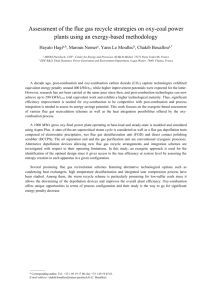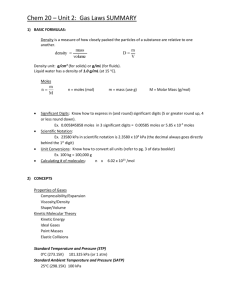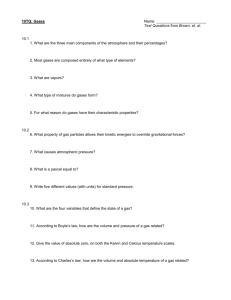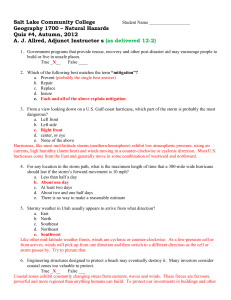CONDENSATION OF FLUE GASES IN BOILERS
advertisement
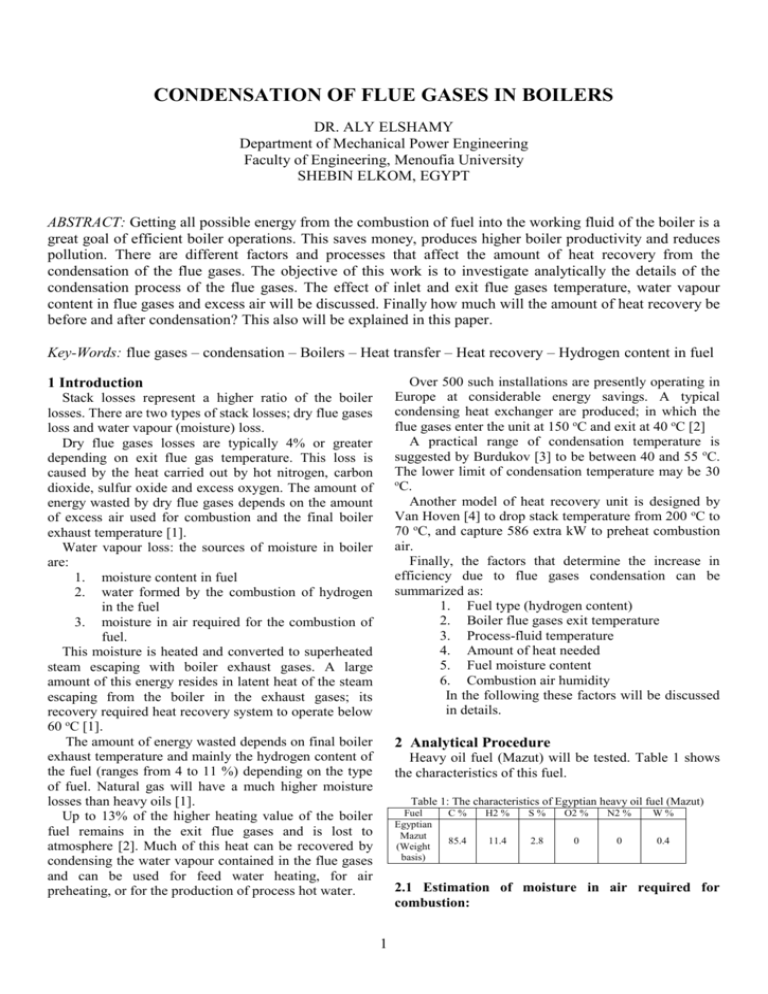
CONDENSATION OF FLUE GASES IN BOILERS DR. ALY ELSHAMY Department of Mechanical Power Engineering Faculty of Engineering, Menoufia University SHEBIN ELKOM, EGYPT ABSTRACT: Getting all possible energy from the combustion of fuel into the working fluid of the boiler is a great goal of efficient boiler operations. This saves money, produces higher boiler productivity and reduces pollution. There are different factors and processes that affect the amount of heat recovery from the condensation of the flue gases. The objective of this work is to investigate analytically the details of the condensation process of the flue gases. The effect of inlet and exit flue gases temperature, water vapour content in flue gases and excess air will be discussed. Finally how much will the amount of heat recovery be before and after condensation? This also will be explained in this paper. Key-Words: flue gases – condensation – Boilers – Heat transfer – Heat recovery – Hydrogen content in fuel Over 500 such installations are presently operating in Europe at considerable energy savings. A typical condensing heat exchanger are produced; in which the flue gases enter the unit at 150 oC and exit at 40 oC [2] A practical range of condensation temperature is suggested by Burdukov [3] to be between 40 and 55 oC. The lower limit of condensation temperature may be 30 o C. Another model of heat recovery unit is designed by Van Hoven [4] to drop stack temperature from 200 oC to 70 oC, and capture 586 extra kW to preheat combustion air. Finally, the factors that determine the increase in efficiency due to flue gases condensation can be summarized as: 1. Fuel type (hydrogen content) 2. Boiler flue gases exit temperature 3. Process-fluid temperature 4. Amount of heat needed 5. Fuel moisture content 6. Combustion air humidity In the following these factors will be discussed in details. 1 Introduction Stack losses represent a higher ratio of the boiler losses. There are two types of stack losses; dry flue gases loss and water vapour (moisture) loss. Dry flue gases losses are typically 4% or greater depending on exit flue gas temperature. This loss is caused by the heat carried out by hot nitrogen, carbon dioxide, sulfur oxide and excess oxygen. The amount of energy wasted by dry flue gases depends on the amount of excess air used for combustion and the final boiler exhaust temperature [1]. Water vapour loss: the sources of moisture in boiler are: 1. moisture content in fuel 2. water formed by the combustion of hydrogen in the fuel 3. moisture in air required for the combustion of fuel. This moisture is heated and converted to superheated steam escaping with boiler exhaust gases. A large amount of this energy resides in latent heat of the steam escaping from the boiler in the exhaust gases; its recovery required heat recovery system to operate below 60 oC [1]. The amount of energy wasted depends on final boiler exhaust temperature and mainly the hydrogen content of the fuel (ranges from 4 to 11 %) depending on the type of fuel. Natural gas will have a much higher moisture losses than heavy oils [1]. Up to 13% of the higher heating value of the boiler fuel remains in the exit flue gases and is lost to atmosphere [2]. Much of this heat can be recovered by condensing the water vapour contained in the flue gases and can be used for feed water heating, for air preheating, or for the production of process hot water. 2 Analytical Procedure Heavy oil fuel (Mazut) will be tested. Table 1 shows the characteristics of this fuel. Table 1: The characteristics of Egyptian heavy oil fuel (Mazut) Fuel Egyptian Mazut (Weight basis) C% H2 % S% O2 % N2 % W% 85.4 11.4 2.8 0 0 0.4 2.1 Estimation of moisture in air required for combustion: 1 Vg 1 1.306(1 ) Vo ash / 100 The partial pressure of water vapour (humidity) in air can be calculated from the equation: (1) P v ( RH ).Psat / 100 (Pa) (8) Where, RH: the relative humidity of air % Psat: the saturation pressure of water (Pa) at (tair) tair: the ambient air temperature The ratio of water vapour X2 can be calculated by: PH2O VH2O (9) X2 Pg Vg A correlation for the relation between Psat and tair is done by the Author of this paper using data given in [6], the relation is: The total water vapour content in flue gases X, can be taken as a summation of equation (4) and equation (9) as: (Pa) (10) X X1 X 2 3 2 Psat 0.001t 4 a 0.0356t a 3.874t a 5.6853t a 785.7 (Pa) (2) The volume of water vapour in air can be calculated by: Vv Vv P (m3/kgfuel) (3) v Vtot Vg Vv Ptot 2.2.1.1 Calculation of the heating value of the fuel The Mendeleyev formula will be used to calculate the lower heating value (CV) per 1 kg of fuel as: Where, Ptot : the ambient pressure = 101325 (Pa) Vg: the volume of dry gases (m3/kgfuel) Vv: the volume of water vapour (m3/kgfuel) CV = 338 C + 1256 H2 -109 (O2 – S) – 25 (H2 +W) (kJ/kgfuel) (11) Where, C, H2, O2, S and W are the weight percentage of carbon, hydrogen, oxygen, sulfur and moisture content in fuel respectively. Equation (3) can be arranged as: X1 Vv Pv / Ptot Vg 1 Pv / Ptot (4) 2.2.1.2 Calculation of the dew point temperature A correlation is set by the author to estimate the dew point temperature as a function of the partial pressure of water vapour using tables in [7] as: Where, X1: the ratio of the volume of the water vapour in the air o t dp 19.696 ln( X ) 132.84 ( C) 2.2 Estimation of water vapour formed by the combustion of hydrogen content in fuel 2.2.1 For the solid/liquid fuel The volume of water vapour formed by the combustion of hydrogen and moisture contents in solid/liquid fuel can be given by [7]: V H 2O 0.111H 2 0.0124W 0.0161(1 ) Vo 100 2.2.1.3 Calculation of the heat of water vapour and dry flue gases 2.2.1.3.1 Without condensation of the water vapour (tex>tdp): In this case the heat recovery from water vapour will be sensible because no condensation takes place. So, the total heat recovery from flue gases = the sensible heat from water vapour + the sensible heat from dry flue gases Vo 0.089( C 0.37S ) 0.265H 2 0.33O2 (m3/kgfuel) (6) Where, C, S, H2 and O2: carbon, sulfur, hydrogen and oxygen contents in the fuel % The quantity of water can be given by: (7) m VH O * H O (kg/kgfuel) 2 (12) (the equation is valid in the range: 0tdp100 oC and 610.7X101325 Pa Where, X: the partial pressure of water vapour in Pa (m3/kgfuel) (5) Where, H2: hydrogen content in the fuel % W: moisture content in the fuel % : the excess air Vo : the theoretical volume of air required for combustion, it can be calculate from: H 2O (m3/kgfuel) The sensible heat of the water vapour can be estimated by: 2 Where, H2O: the density of water vapour (superheated steam) = 0.804 kg/m3 given by:[7] QS vapour mH 2O * Cp vapour ( t in t ex ) (kJ/kgfuel) (13) Where, mH2O: the quantity of water vapour (Kg/kgfuel) The total volume of flue gases can be calculated from: 2 Cpvapour: The specific heat of water vapour = 1.865 kJ/Kg.oC [7] tin: the inlet temperature of flue gases to the heat recovery unit in (oC) tex: the exit temperature of flue gases from the heat recovery unit in (oC) tdp: the dew point temperature of the water vapour in (oC) Q LH H S liquid (17) H 2O p liquid in ex (18) Cpliquid: The specific heat of liquid water = 4.18 kJ/Kg.oC The total sensible heat from water (liquid and vapour phases) is given by: (kJ/kgfuel) (19) Q Q Q Qg mgCp ( t in tex ) (kJ/kgfuel) (14) g mg: the quantity of dry flue gases (Kg/kgfuel) = mfuel (1 (1 ) Vo mH O 2 m H 2O * L heat (kJ/kgfuel) The sensible heat of the water (liquid phase) when the exit temperature decrease under the dew point is given by: Q m *C ( t t ) (kJ/kgfuel) The sensible heat of the dry flue gases can be estimated by: Where, 2O SHH2O S vapour Sliquid The total heat recovery in this case can be given Cpg: The specific heat of dry flue gases = 1.08 kJ/Kg.oC tin: the inlet temperature of the flue gases to the heat recovery unit in (oC) tex: the exit temperature of flue gases from the heat recovery unit in (oC) by: Qtot QSHH O QLH H O Qg (kJ/kgfuel) 2 2 (20) The increase in the efficiency of the boiler is given by: Boiler The total heat recovered from the water vapour and flue gases is given by: (15) Qtot QS vapour Qg (kJ/kgfuel) Q tot * 100 % CV (21) Where, CV: The heating value of the fuel (kJ/kg) 2.3 Calculation of the annual fuel and currency savings 2.2.1.3.2 With condensation of the water vapour (tex<tdp): In this case, the latent heat captured from the water vapour Tin and the Latent heat sensible Tdp heat of condense Sensible heat d vapour (vapour phase) will be added. Sensible heat Tex The (liquid phase) total heat of flue gases = the total sensible heat from water vapour before condensation + the latent heat of the water vapour + the sensible heat of water (liquid phase) after condensation + the sensible heat of dry flue gases The annual saving in the fuel consumption can be calculated by equation given in [8] as: mfuel Boiler * mfuel (ton/year) (22) Boiler Where, Boiler: The boiler efficiency (=85 % as an average value) mfuel: The fuel flow rate (kg/year) = 2.1702x106 million ton/year (Mazut consumption in power stations in Egypt) The annual currency saving can be calculated from the formula given by [8] as: Saving ($) mfuel * price (million $/year) (23) Where, $) price: price of 1 ton of Mazut (is taken as 120 The following equation is given as a correlation of latent heat as a function of partial pressure (X): 3 Results and Analysis Lheat 0.0614X 2 5.8402X 2476 (kJ/kg) A computer program is designed and tested for the previous equations. The analysis and discussion of these results will be introduced in the next sections. (16) The total latent heat gain from the water vapour is calculated from: 3 3.1 The effect of the inlet temperature of the flue gases Q(H2O)/Q(dry gases) % 1200 Total Heat recovery, Qtot, (kJ/Kgfuel) The effect of the inlet temperature of the flue gases on the amount of heat recovery from the boiler and on the increase in boiler efficiency are shown in figs. 1 and 2. 6000 5000 Just after condensation, Tex=53 deg. C Just after condensation, Tex=53 deg. C 800 600 400 200 Just before condensation, Tex=55 deg. C 0 80 4000 100 120 140 160 Inlet temperature, deg. C Fig.(3) The heat recovery ratio between water vapour and dry flue gases against inlet temperature of flue gases (Tdp=53.82 deg.C, Mazut Fuel) 3000 2000 Just before condensation, Tex=55 deg. C The results shows that this ratio increases sharply (just after condensation) when compared with the ratio (just before condensation). As shown from fig.3 the ratio ranges between about 250% up to more than about 1000 % for inlet temperature of flue gases changes from 160 to 80 oC respectively, While just before condensation, the ratio is fixed at about 20 % for any value of the exit temperature of the flue gases. This shows how the condensation process of the water vapour. In the flue gases is effective. 1000 0 80 100 120 140 Inlet temperature, deg. C 160 Fig.(1) Total heat recovery against inlet temperature of flue gases (Tdp=53.82 deg.C, Mazut fuel) From Fig.1 it is clear that the increasing the inlet temperature of the flue gases, the increasing the amount of heat recovery either before or after condensation. It is also very clear that the amount of heat recovery just after condensation (the upper line) increased sharply if it is compared with the amount just before condensation (the lower line). This is due to the capture of the latent heat of water vapour due to condensation. Heat recovery from H2O & Dry fllue gases (kJ/Kgfuel) 3.2 The effect of the exit temperature of the flue gases: Fig.2 shows the increase in boiler efficiency of the boiler for different values of inlet temperature of the flue gases. From this figure, it is clear that the increase in the 14 12 Boiler Efficiency increase % 1000 10 8 6000 Dew point 5000 4000 3000 Water vapour Dry flue gases 2000 Total 1000 0 40 50 60 70 80 Exit temperature, deg. C 6 Fig.(4) Heat recovery modes against exitt temperature of flue gases (Tdp=53.82 deg.C, Mazut fuel) 4 2 0 80 100 120 140 Fig. 4 Shows the effect of the exit temperature of the flue gases on the amount of heat recovery from (the dry flue gases and from the water vapour). It is clear that the decreasing the exit temperature, the increasing the amount heat recovery from both the dry flue gases and the water vapour. Just (before/after) the dew point temperature, a dramatic change in the amount of the heat recovery has been occurred for the water vapour (dashed line) and in frequently for the total amount of the heat recovery. 160 Inlet temperature, deg. C Fig.(2) The increase in the efficiency of boiler against inlet temperature of flue gases (Tdp=53.82 deg.C, Mazut Fuel) efficiency change ranged from 1 to 4 % (just before condensation), while the efficiency increases from 10 to 13 % (just after condensation). This indicates clearly how the condensation of the water vapour in the flue gases affects on the efficiency increase. Fig.3 indicates the effect of inlet temperature on the ratio between the heat recovery from the water vapour and the heat recovery from the dry flue gases, (just before condensation tex = 55 oC) and just after condensation tex=53 oC). Figs. 5A and 5B present the ratio of the two modes of heat recovery (Water vapour & dry flue gases). Just before condensation (tex=55oC) the ratio is 17 while 83 4 just after condensation (tex=53oC) Fig. (5A) Presentation of heat recovery modes before condensation the ratio is (Tex=55 deg.C) 77 for the Water 23 vapour same 17% conditions of inlet temperature Dry flue of the flue gases gases and the 83% same fuel. This is very clear, because in the case (just before condensation) the most amount of the heat recovery comes from Fig. (5B) Presentation of heat recovery modes the sensible after condensation heat of the (Tex=53 deg.C) dry flue gases while Water liquid the sensible 77% heat of the water vapour is small. But Dry flue (just after gases Mazut annually and will save about((180 million $) annually. 3.3 The effect of excess air of required for the combustion Fig.7 shows the effect of the excess air ratio on the amount of heat recovery from the water vapour, dry flue gases and total heat recovery. The effect of the excess air ratio affects on the heat recovery of the dry flue gases only, and approximately no effect on the heat recovery from the water vapour. This is due to the increase in excess air will increase the amount of the amount of air added, and in turn increases the amount of flue gases. While the influence of the The amount of heat recovery, kJ/Kgfuel 6000 4000 Qtot H2O Qdry gases Qtot 3000 2000 1000 0 0 10 20 30 40 Excess air % 23% Fig. (7) The effect of excess air on the amount of heat recovery condensation) the latent heat captured from the condensation of the water vapour and the sensible heat of the condensed water are added to the amount of heat recovery from water vapour, this increases the ratio of heat recovery from the water vapour. excess air is only limited because a very little change will happen to the water vapour content. 4 Fig.6 indicates the annual savings in fuel consumption and in currency for different values of the exit temperature of the flue gases. The results here are calculated based on the annual fuel consumption of Mazut in different thermal power stations in Egypt (it is about 2.1702 million ton Mazut). The price of 1 ton of Mazut is considered as about 120 $. As shown from fig.6 it is clear that the 350 REMEDY OF SOME PROBLEMS ACCOMPANIMENT WITH THE CONDENSATION OF THE FLUE GASES: 4.1 The problem of the additional costs due to the installation and operation of the Heat Recover Condensation Unit (HRCU): The application in USA and Europe since 1980 have shown that from 1 to about 2 years payback is expected [2] and [4]. 70 300 Annual fuel saving (thousand ton) 60 250 Annual currency saving (million $) 50 200 40 150 30 100 20 50 10 0 Annual Saving (million $) Annual fuel saving, (thousand ton) 5000 4.2 The corrosion problem: The HRCU can usually be prevented from corrosion by using type 304 or 316 stainless steel or fiber glassreinforced plastic or glass surfaces [8]. 4.3 Emissions: 0 40 50 60 Exit temperature, deg.C 70 A unique feature of the HRCU is that it recovers energy while also reducing emissions. In addition, when natural gas is burned, a small percentage of NOx emissions are reduced by condensation of NOx. 80 Fig. (6) Annual saving in fuel and currency due to the heat recovery in Egyptain power station (Mazut) condensation of the flue gases in different boiler power stations in Egypt will save about (300 million ton) of 5 SO2 emissions can be reduced significantly by using alkaline water spray in a pH range of 6 to 8. REFERENCES: [1] Harry R. Taplin, "Reduction energy costs of boilers", Energy Engineering, Vol. 92, No. 5, pp. 18-26, USA, 1995. [2] R. E. Tomson, "Condensing flue-gas water vapour: Another way to cut your fuel bill", Power, pp. 7982, May 1983. [3] A. P. Burdukov, Yu. N. Dubinski and V. A. Zubkov, "Recovery of the heat of condensation of water vapour from flue gases of solid powergenerating fuels", Thermal Engineering, Vol. 43, No. 2, 1996 [4] Van Hoven, "Condensing heat exchanger captures flue-gas latent heat:, Power, February 1982 [5] Fagersta AB, "Cooled flue gases save energy in large boilers", Energy conservation, the Swedish way, Stockholm, 1989. [6] Y. A. Cengel and M .A. Baes, "Thermodynamics: An engineering approach", McGraw Hill, USA, 1998. [7] I. Shevts, V. Tolubinsky, N. Kirakovsky, I. Neduzhy and I. Sheludko, "Heat engineering", Mir Publishers, Moscow, 1987. [8] A. Elshamy, R., "Investigation and development of glass tube air heater as a method for increasing boiler efficiency", PhD thesis, Faculty of Engineering, Menoufia University, Shebin El-Kom, Egypt, 1996. 5 Conclusions: From the results of this work, the following conclusions can be obtained: 1. The condensation of the flue gases in boilers by using the heat recovery condensation units (HRCU) can lead to a high increase in the boiler efficiency by about 14 % or more depending on the inlet and the final temperatures of the flue gases and the hydrogen fuel content. 2. The condensation of the flue gases results in a dramatic increase in the ratio of heat recovery from water vapour and dry flue gases from 250% to 1000 % or more depending on the inlet and exit temperatures of the flue gases. 3. An annual savings in fuel consumption in thermal power stations in Egypt up to 300 thousands ton of Mazut, can be obtained when HRCU are installed. 4. An annual saving in hard currency up to 65 million $ can be obtained when HRCU are installed in different thermal power stations in Egypt Finally, it is strongly recommended to apply the HRCU in different thermal power stations in Egypt. [9] http://www.cipco.apogee.net/ces/hstfg.asp [10] http://www.tekes.fi/opet/loimaa.htm 6
